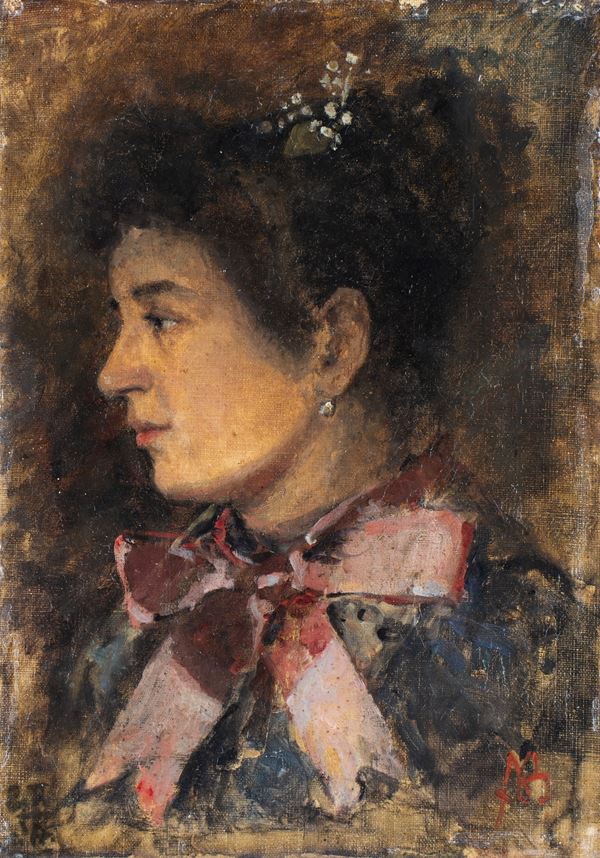Amedeo Modigliani (Livorno, 1884 - Parigi, 1920)
Portrait of Medea Taci
Signed lower right. On the reverse: inside the right margin of the canvas: "A. Modigliani".
Exhibitions: 2005, Modigliani in Venice, between Livorno and Paris, May - July, Biblioteca Nazionale Marciana, Venice; July - September Castello di San Michele, Cagliari (rep. in cat. p. 35); 2005, Modigliani in Domodossola, from Venice to Paris, May - July, Marciana National Library, Venice; July - October, Castello San Michele, Cagliari; October - December, Sala Motta, Domodossola (rep. in cat. p. 35); 2009, Amedeo Modigliani, April - July, Kunst und Ausstellungshalle der Bundesrepublik Deutschland, Bonn; 2011, Modigliani Portraits of the soul, December - February, Castello Ursino, Catania, (repr. in cat. p. 14).
Bibliography: 2006, Modigliani La Vita Le Opere, C. Parisot, Carlo Delfino Publisher - Edizioni Carte Segrete, p. 24; 2008, Modigliani l'artiste italien, V. Goriainov, C. Filippini, C. Parisot, Editorial Giorgio Mondadori, p. 105; 2009, Amedeo Modigliani, a mythos der modern, Dumont, p. 152; 2012, Modigliani Catalog Raisonné, C. Parisot, volume V, Forma Edizioni, p. 44.
Work subject to notification by the Superintendence with n. prot. 10835 dated 4 August 2010.
The small painting depicts the young Medea Taci, who passed away in 1898, at the age of only twenty, following meningitis. It is therefore a posthumous portrait, probably based on a recently identified photograph.
Medea Taci was one of the three children of Tito Taci, a hotel entrepreneur, who came from Florence to Iglesias in 1870, where he founded the "Leon" hotel d'Oro", opened in 1872 and very popular. Tito Taci and Flaminio Modigliani, Amedeo's father, were linked by friendship and professional relationships, cemented over many years of association with their respective families. Flaminio Modigliani had arrived in Sardinia at a very young age to take care of agricultural and mining interests in the Gessa area (Iglesiente), purchased by his father Emanuele Abramvita Modigliani in 1862. The Modigliani family, made up of Flaminio and his wife Eugenia Garzin, was divided between Livorno , where the mother lived with her three children and Iglesias where the father took care of the business and the family moved for the summer holidays. Amedeo, as a boy, having lost the large Grugua agricultural estate in Salto di Gesso due to economic failure, continued to go to Iglesias, staying at the Golden Leon where he became friends with the Taci boys, in particular with Medea depicted here. The painting was always preserved by the Taci family and kept for decades by her sister Clelia in Belgium, who in turn donated it to her nephews Meloni, the current owners, with the express wish that it return to Sardinia, a land so loved by Medea. A very rare and happy testimony to the Tuscan painter's youthful production - production almost totally lost, according to the painter's wishes - the painting is the only one to survive from the Sardinian years, even if it remains a memory of another painting exhibited for decades in the offices of the Monteponi Mine . The portrait of Medea is created on a fine canvas with direct touch brushstrokes, without a preparatory layer and without an underlying drawing, the chromatic material is thin and thin, so much so that it allows the underlying canvas to shine through; the state of conservation is also good thanks to constant maintenance. A pleasant work in its earth-based chromatic arrangements, the profile portrait fits into the tradition of contemporary Tuscan Macchiaioli painting, revealing bourgeois ways close to Silvestro Lega but also reminiscent of the popular portraiture of F. M. Michetti and A. Mancini. For the purposes of this declaration procedure, it should be underlined that the work is of particularly important interest from a twofold perspective. In fact, the painting is very significant in the artistic life of the great modernist painter, as it constitutes one of the very few documents of his youthful activity; secondly, the work is of interest to local history as it testifies to the cultural presence of important Tuscan entrepreneurial families in post-unification Sardinia, aimed at industrial and mining development.
Historical-artistic report by the Instructor Officer Maura Picciau .

